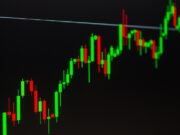April 12, 2025
Every successful investor knows a painful truth: knowing when to sell is often more critical than knowing what to buy.
While financial media overwhelmingly focuses on buying opportunities, our research consistently identifies companies facing significant headwinds that merit serious consideration for selling. These aren’t just stocks underperforming the market; they’re businesses confronting structural challenges, deteriorating fundamentals, or carrying valuations disconnected from financial reality.
What you won’t find here: reactionary calls based on short-term price movements or headline volatility. Each company on this list has been thoroughly analyzed across multiple metrics that historically precede substantial declines.
Smart investors understand that portfolio management requires both addition and subtraction. Sometimes the best investment decision is to redeploy capital away from troubling positions before problems fully materialize in the share price.
This week’s watchlist highlights stocks showing critical weaknesses that demand immediate attention:
Boeing (BA)
Boeing faces mounting headwinds as trade tensions intensify, with the stock dropping 3.39% on Thursday despite the previous day’s tariff-pause rebound. While President Trump implemented a 90-day pause on most new tariffs, the base 10% tariff on nearly all imports remains in effect, and Chinese import tariffs have been dramatically increased to 145%. This uncertain policy environment creates multiple pressure points for an aerospace manufacturer already struggling with production issues and regulatory scrutiny.
The financial implications for Boeing are particularly concerning given its already precarious margin situation. With a negative gross margin of -2.94%, the company has zero buffer to absorb rising costs from tariffs on raw materials like steel and aluminum, or the inevitable price increases from suppliers facing similar pressures. Trading at $155.37, down from its 52-week high of $196.95 but still commanding a substantial $121 billion market capitalization, Boeing appears significantly overvalued considering these margin challenges and the probability of further earnings deterioration as tariff impacts cascade through its supply chain.
The company faces a perfect storm of tariff-related threats: increased production costs, reduced competitiveness versus European rival Airbus as reciprocal tariffs make Boeing aircraft more expensive abroad, supply chain disruptions (exemplified by supplier Howmet Aerospace already declaring force majeure), potential order delays as aircraft purchases become political bargaining chips, and the risk of cancellations if global economic growth slows. With trading volume elevated at 10.3 million shares versus the 8.7 million average, institutional investors appear to be reassessing exposure to these multiple risk factors. Given Boeing’s ongoing operational challenges, tariff vulnerabilities, and negative margins, investors should consider reducing positions before these headwinds fully manifest in upcoming quarterly results.
Intel (INTC)
Intel faces a significant new threat to its already troubled turnaround efforts as revelations about CEO Lip-Bu Tan’s extensive Chinese business ties triggered a 7.62% stock plunge on Thursday. According to a Reuters report, Tan has invested in hundreds of Chinese companies through his investment firm Walden International and two Hong Kong-based holding companies, with some of these investments connected to entities linked to the Chinese military. Most concerning was Tan’s previous seed investment in Semiconductor Manufacturing International Corp. (SMIC), China’s largest chip foundry and a major supplier to the Chinese military that remains under U.S. sanctions.
The timing of these revelations could hardly be worse for Intel, which has seen its market position deteriorate substantially over the past several years. Trading at just $19.89, down from its 52-week high of $37.67 and approaching its low of $17.66, the stock has lost significant value as the company struggles with manufacturing delays, market share losses to AMD, and questions about its strategic direction. Despite these challenges, Intel still commands a substantial $94 billion market capitalization that appears increasingly difficult to justify given its fundamental performance and new leadership concerns.
The extraordinary trading volume of 128.8 million shares versus the 109.2 million average suggests institutional investors are rapidly reassessing their positions in light of these developments. While Intel’s 32.66% gross margin provides some operational cushion, its meager 1.16% dividend yield offers little compensation for mounting risks. Given the semiconductor industry’s critical importance to national security and the heightened U.S.-China tensions, Tan’s Chinese business connections could potentially complicate Intel’s relationships with U.S. government customers and its ability to receive federal subsidies under the CHIPS Act. With regulatory scrutiny likely to intensify and Intel’s core business already under pressure, investors should consider reducing exposure before these leadership concerns potentially derail the company’s turnaround efforts.
Tesla (TSLA)
Tesla’s downward spiral continues with shares plunging 7.14% on Thursday as investors react to President Trump’s decision to raise China import tariffs from an already punitive 104% to an extraordinary 145%. This latest decline brings Tesla’s year-to-date losses to 39% and pushes the stock 48% below its recent valuation peak. The heightened tariffs come at a particularly vulnerable time for Tesla, which has been struggling with slowing sales growth, increased competition, and growing concerns about CEO Elon Musk’s political activities potentially damaging the brand’s appeal to its traditionally progressive customer base.
Despite this significant correction, Tesla’s valuation remains detached from its core automotive business fundamentals. The stock trades at approximately 95.5 times this year’s expected earnings and 7.4 times expected sales – multiples that suggest investors are still pricing in aggressive growth assumptions that appear increasingly unrealistic. With a market capitalization of $876 billion despite deteriorating operational performance, Tesla continues to be valued as though revolutionary new business lines will materialize imminently, rather than on its current financial reality. The company’s 17.86% gross margin, while superior to traditional automakers, has been trending downward as price competition intensifies in key markets.
The extraordinary trading volume of 180.7 million shares versus the 106.9 million average indicates institutional investors are actively reassessing positions. While bulls point to the potential of robotaxi services as a future growth driver, the timeline for meaningful revenue contribution from this initiative continues to stretch further into the future with each passing quarter. The stock’s current trading range of $239.33-$262.48, while well above its 52-week low of $138.80, appears vulnerable to further compression as market sentiment shifts from growth-at-any-price to fundamental valuation metrics. For investors still holding positions, the combination of elevated multiples, deteriorating China relations, and weakening core business performance suggests now may be an opportune time to reduce exposure before further valuation rationalization occurs.
Bottom Line
This week’s featured companies illustrate the far-reaching implications of escalating trade tensions, particularly with China. Boeing’s negative margins leave it exceptionally vulnerable to tariff-induced cost increases, Intel’s new CEO faces potential conflicts of interest that could complicate government relationships during a critical turnaround period, and Tesla’s still-lofty valuation multiples appear increasingly disconnected from business realities as China tariffs threaten its global operations. In each case, the market’s initial reaction appears to be just the beginning of a potential broader reassessment as these complex challenges unfold in the coming quarters.






